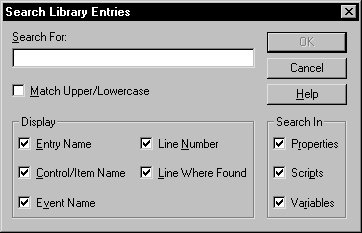You can search a target to locate where a specified text string is used. For example, you could search for:
All scripts that use the SetTransObject function
All windows that contain the CommandButton cb_exit (all controls contained in a window are listed in the window definition, so they can be searched for as text)
All DataWindow objects accessing the Employee table in the database
![]() Working with targets
To see the pop-up menu that lets you perform operations such
as search, build, and migrate on a target, you must set the root
of the System Tree or the view in the Library painter to the current
workspace.
Working with targets
To see the pop-up menu that lets you perform operations such
as search, build, and migrate on a target, you must set the root
of the System Tree or the view in the Library painter to the current
workspace.
You can also select a library or one or more PocketBuilder objects to search using the Search Library Entries dialog box.
Figure 4-3: The Search Library Entries dialog box

The following procedure applies whatever the scope of your search is.
![]() To search a target, a library, or objects for
a text string:
To search a target, a library, or objects for
a text string:
Select the target, library, or objects you want to search.
You can select multiple objects in the List view using Shift+Click and Ctrl+Click.
Select Search from the pop-up menu or the PainterBar.
The Search Library Entries dialog box displays.
Enter the string you want to locate (the search string) in the Search For box.
The string can be all or part of a word or phrase used in a property, script, or variable. You cannot use wildcards in the search string.
In the Display group box, select the information you want to display in the results of the search.
In the Search In group box, select the parts of the object that you want PocketBuilder to inspect: properties, scripts, and/or variables.
Click OK.
PocketBuilder searches the libraries for matching entries. When the search is complete, PocketBuilder displays the matching entries in the Output window.
For example, the following screen displays the results of
a search for the string SetTransObject.
Figure 4-4: Results from a library search for SetTransObject

From the Output window, you can:
Jump to the painter in which an entry was created
To do this, double-click the entry or select it and then select Edit from the pop-up menu.
Print the contents of the window
Copy the search results to a text file